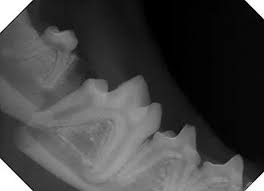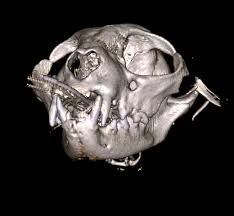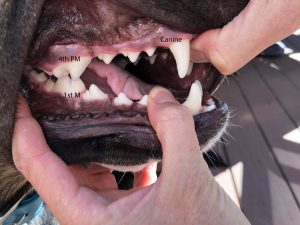Trauma and Mandibular Fractures in Dogs
Broken jaws in dogs, often caused by trauma, can happen for various reasons. A mandibular fracture is one of the most common types of jaw fractures in dogs. These fractures often occur due to vehicular trauma, where a dog gets struck by a car or any other motor vehicle. Another frequent cause of a broken jaw is a dogfight, where the dog may get injured from a bite or a bump during the altercation. In these cases, it’s important to get your four-legged companion to the emergency clinician for prompt evaluation and treatment.

Preexisting Conditions and Jawbone Weakness
A weakened jawbone or periodontal disease can also predispose your dog to injuries like a broken jaw. In these situations, even a mild incident such as chewing on a toy or a fast-moving ball could lead to a jaw fracture. Bone loss due to aging or disease can make your dog’s mandible more vulnerable to fractures. If your dog has a history of periodontal disease or chewing on hard kibble, it’s best to have the patient regularly evaluated by your regular veterinarian to prevent life-threatening injuries. If the injury happens, seeking emergency care is crucial, as pieces of the jawbone can sometimes splinter, requiring stabilized treatment in the hospital. Accidents, fights, or any form of high-risk activity can cause severe jaw fractures, so always keep an eye on your pooch during playtime or outdoor activities.
Treating Jaw Fractures in Dogs
When your dog sustains a jaw fracture, it’s important to act fast. After an initial assessment, the patient will need to be examined thoroughly. The starting point of treatment is often a physical exam and blood work, which helps to assess if your dog is stable enough for further procedures. Radiographs, including skull radiographs, will provide critical diagnostics to understand the full extent of the fracture. In some cases, your dog may need to be sedated or even anesthetized for proper diagnostic imaging, such as dental radiographs or a CT scan to get a detailed view of the fracture site. Your regular veterinarian or an emergency clinician will help evaluate the condition and determine if advanced imaging techniques like cone beam CT scan or helical CT scan are necessary.
Once the diagnostics are complete, treatment can begin. For fractures, your dog may need oral surgery from a veterinary dentist or specialized Animal Dental Care centers. Depending on the severity, anesthesia will be required to ensure your dog remains still during the procedure. The oral cavity will be carefully examined, and the fracture site will be repaired using various methods like sutures or plates to stabilize the teeth and jawbone. In veterinary practice, it’s important to follow up on any complications or the potential for additional injuries. This allows the veterinary team to ensure your dog heals properly and stays pain-free through the recovery process. Regular visits to the vet can help track your dog’s progress and ensure the best outcome.

Figure 3. Three-dimensional reconstruction from cone computed tomography scan of a cat with a fracture of its zygoma bone. The fracture was the result of being attacked by a dog. The CBCT scan was completed at Animal Dental Care and Oral Surgery in Colorado Springs.
When a dog suffers a jaw fracture, the fracture repair process begins with a thorough planning stage. The goal is to restore occlusion and prevent any damage to the remaining teeth. During fracture repair, the fracture location and the number of fractures must be carefully assessed. The direction and fracture line will determine the most suitable treatment technique. If the fracture involves significant damage to the oral tissues or teeth, such as oral lacerations or bone exposure, special care is needed to ensure healing. A functional reduction of the fracture is critical to realign the mandibles and ensure rigid fixation to allow for proper bony union.
To stabilize the jaw fracture, a variety of techniques may be used, such as interdental splints, cerclage wires, or intraosseous wires. In some cases, composite material may be applied to the teeth to help with fracture stabilization. Additionally, oversized muzzles are sometimes used to keep the fracture from shifting. Suturing the oral lacerations helps keep the oral tissues in place and prevents infection. Post-treatment, the patient will need to be monitored for occlusion and general recovery, ensuring that the alignment of the teeth is restored for normal function. The primary focus is on improving the dog’s quality of life, allowing them to eat, chew, and live without pain or discomfort.

Figure 4. Acrylic composite material that has been used to stabilize a jaw fracture. The acrylic is left in place for 4-8 weeks
Taking Care of Your Dog after Jaw Surgery
After your dog undergoes jaw surgery to repair a fracture, proper home care is essential for a successful recovery. Following the repair technique, your veterinarian will provide you with detailed instructions for at-home care. It’s important to keep your dog confined to minimize pressure on the healing bone. Exercise restrictions are crucial, so avoid running, playing, or jumping, as these activities can disrupt the healing process. A soft diet, with food that has a gruel-like consistency, will be recommended to prevent any stress on the mouth. In some cases, a feeding tube may be necessary if your dog can’t tolerate solid food. Feeding instructions will be clearly written down for your reference, and you’ll need to carefully follow these to ensure your pet gets the proper nutrition without putting too much pressure on the surgical site.
During the recovery process, your dog may need to stay on a leash to help you control their movements and prevent further injury. You may also be instructed to remove any splint or wire that was used in the anesthetized procedure. Although the process can seem daunting for pet owners, the goal is to keep your dog comfortable and help them heal effectively. Make sure you regularly check the area for any signs of discomfort or complications, and if necessary, adjust the treatment to suit your dog’s needs. Keep in touch with your vet to monitor progress and ensure everything is proceeding as expected.
Are There Complications to Treating a Broken Jaw?
When it comes to treating jaw fractures in dogs, there are a few complications that could arise. One of the major concerns is the malalignment of the fracture site, which can lead to teeth misalignment if not properly addressed. Even with surgical procedures such as using metal plates, screws, or wires, some dogs may experience malunion or nonunion, where the bones don’t heal correctly. In these cases, the healing fracture might be unstable, requiring more frequent checkup exams to ensure proper recovery. During these exams, the vet may need to monitor and observe the healing process using x-rays to track the progress.
Additionally, infection is a potential risk when dealing with surgical incision sites or tearing around the fracture site. If not carefully managed, it could delay healing or lead to further complications. To aid recovery, the dog may need to abstain from activities like chewing hard food or playing with hard toys, as these actions can potentially dislodge splints or interfere with alignment. Instead, the vet might recommend soft food to prevent any strain on the fracture. After the splint is removed, a period of careful transition is often required to ensure the jaw is fully healed before the dog can return to normal eating and play.
Veterinary Dentist in Colorado Springs
When treating your pet’s oral health, a Veterinary Dentist in Colorado Springs can offer the best options to keep your four-legged companion pain-free and with a functional bite. Many of these specialists focus on Animal Dental Care and provide services like Oral Surgery to ensure that any dental issues don’t affect your pet’s life or comfort. Whether it’s an annual dental cleaning or an emergency procedure, these professionals strive to provide the best quality care, maintaining proper occlusion and addressing any potential issues before they worsen. By focusing on dental care, they help keep your patients healthy and happy, free from oral pain.
The Prognosis for a Jaw Fracture Repair
The prognosis for jaw fracture repair in dogs is generally good to excellent, especially for mandibular fractures, which often heal well when the injury is stable. However, there are some exceptions, like maxillary fractures, which can be more variable and might require more complex care. The severity of the injury, the cause of the fracture, and even the duration of the trauma all play a role in the dog’s recovery. For instance, a minor trauma or mild fall might lead to a great prognosis, while older dogs or those with periodontal disease may experience a slower healing process.
The outcome of a fracture repair can be influenced by factors such as the neurovascular blood supply to the area, which can be reduced by severe trauma or impact force. In cases where there is bacterial contamination or complications, the prognosis may be guarded or even poor. In some situations, such as with small-breed dogs, the healing characteristics may be different, and surgical extractions could be necessary. If the injury is severe, the fractures may not heal as expected, leading to a fair prognosis that requires ongoing care and management.
How to Feed a Dog With a Broken Jaw
After your dog has undergone jaw surgery, it can be a challenging time for both the pet owners and the dog. Your pup may struggle with eating, especially if they are still healing from the jaw repair. However, following your vet’s instructions carefully can help them recover quickly and comfortably.
If your dog is unable to eat solid food, feeding tubes may be required to ensure they receive proper nutrition during recovery. This is a common procedure, as dogs with a broken jaw often cannot tolerate the usual chewing motions. In such cases, your vet will prescribe liquid-based foods or specially formulated diets to help your pup heal. Soft foods like wet canned food or pureed food are often recommended for these patients, as they reduce strain on the fractured area. It may take time for your dog to adapt to the feeding tube or softened kibble, but don’t worry—this is all part of the recovery process.
To ensure your dog is getting the proper nutrition, it’s important to monitor their eating habits closely. If your pup is losing weight, consider feeding them smaller meals more frequently throughout the day. This will help to adjust their feeding routine to make sure they eat more without overexerting their healing jaw. In some cases, pain medications may be prescribed to reduce discomfort during meals, which can help your dog feel more comfortable and coax them into eating. Always consult your vet if you notice any signs that your dog is unable to eat or if their recovery isn’t progressing as expected.
If you’re feeling uncertain about the best approach to feeding your dog during their recovery, don’t hesitate to contact your vet for advice. They will guide you in making adjustments to the feeding schedule and ensure your four-legged friend is on the right track to healed health.
Why is it important to treat a broken jaw?
Treating a broken jaw in your dog is crucial for proper healing and to prevent improper healing. A jaw fracture can cause significant discomfort, making it difficult for your dog to eat, leading to nutritional issues. If the fracture involves the upper jaw or lower jaw, it may also affect teeth alignment and could lead to long-term problems like misalignment or damage to nerves and blood vessels. Without proper treatment, your dog might feel worse, and their ability to regain normal mouth function will be hindered. Surgery is often necessary to ensure that the jaw heals correctly and that the dog can eat and rest comfortably without causing further harm. The goal of treatment is to restore function, alleviate discomfort, and prevent any long-term issues from arising.
What to Expect After Treating a Dog’s Broken Jaw
After repairing a broken jaw, your dog will likely need some time to recover. For mandibular fractures and maxillary fractures, the stability of the jaw will be carefully monitored, and in most cases, the prognosis is good with highly effective treatment. However, if the injury was caused by a fall or accident, the severity of the damage can affect the recovery. In some cases, older dogs or those with small size may experience a more challenging recovery. You may notice some swelling or discomfort as your dog heals, and there may be a slight risk of bacterial infection due to the disruption of the blood supply. If the injury was severe, dental issues could also arise. But with proper care and attention, most dogs can sustain a favorable outcome, although exceptions do exist based on the cause and the severity of the fracture.
Repairing a Dog’s Broken Jaw
When it comes to repairing a dog’s jaw fracture, the veterinarian typically uses metal plates, wires, and screws to properly align the bones and ensure the fracture site heals correctly. Sometimes, acrylic splints are used to keep the jaw in place, making it easier for your dog to recover. This is done during a surgical procedure where your dog is anesthetized to ensure they are comfortable and still. The vet will also assess the fracture using X-rays to confirm the fracture site and ensure everything is properly positioned. During the recovery process, your dog will need to avoid chewing hard food, toys, or any hard objects for several weeks. A soft food diet is recommended to help prevent any strain or injury to the healing jaw. Once the jaw is fully healed, the wires or splints may be removed in a scheduled follow-up visit.
Can a dog recover from a broken jaw?
The good news is generally jaw fractures heal fairly well. But it depends on the fractures itself and the health of surrounding bone and teeth
How do I tell if my dog has a broken jaw?
Symptoms of mandibular fractures include:
- reluctance to eat.
- bleeding from the mouth.
- malalignment of the jaw.
- wounds around the mouth, pain and swelling in the region, a persistently open mouth.
- excessive salivation that may be blood-tinged (Figure 2)
How much does it cost to fix a dog’s broken jaw?
Canine dental surgery can fetch you between $150 to $600, while extensive oral surgery on fractured jaws on dogs can cost at least $2000
Can a dog eat with a fractured jaw?
A dog with a broken jaw will need to eat different foods or use a feeding tube. Initially, a feeding tube may be necessary while they adapt to their new situation. Feeding tubes can sound scary to pet owners, however, most patients adjust quickly and tolerate the feeding tube very well.
Pimple-Like Bump on Your Dog?
When you notice pimple-like bumps on your dog’s skin, it might be due to dog acne, a condition similar to acne in humans. Just like humans, dogs can experience blemishes, pimples, or even red lumps on their face or body. These pimple-like bumps can be caused by a variety of factors, such as dirt, oil, debris, and hormonal changes affecting the pores. During puberty, your dog might develop pimples or bumps as their body goes through hormonal changes. This can lead to swelling, redness, and pustules that cause discomfort and itching. These pimples can even develop into cysts or abscesses if left untreated, creating a more serious threat to your dog’s health.
Spaying & Neutering 101
When you adopt a dog, the decision to have them spayed or neutered is an important one. Many dog owners may feel unsure about this procedure, but it is a helpful and responsible step to take for the well-being of your canine companion. Spaying for females and neutering for males can help prevent unplanned pregnancies, reducing the load on shelters and rescues. It’s essential to understand the risks involved, but the benefits far outweigh them. The procedure is typically quick and performed by experienced vets. In fact, it’s considered an important step in managing the population of pets in the United States. The ASPCA and other organizations like Redmond strongly encourage these procedures to control the numbers of animals that end up in shelters
Signs of Infection After Spaying
My first week as a small‑town vet in Danbury taught me that even a smooth recovery can surprise pet owners. After the surgery, watch your furry friend for signs like redness, swelling, or a bad smell at the scar; these point to an infection that needs prompt care. I always tell clients to take the dog right away if they see pus, the wound feels hot, or their once‑perky dog seems tired and refuses food—those are common clues the body is fighting back. A quick call lets us expect problems early and keep the animal’s health and well‑being on track.

Pingback: 10 Surprising Benefits of Fish-First Food for Dogs